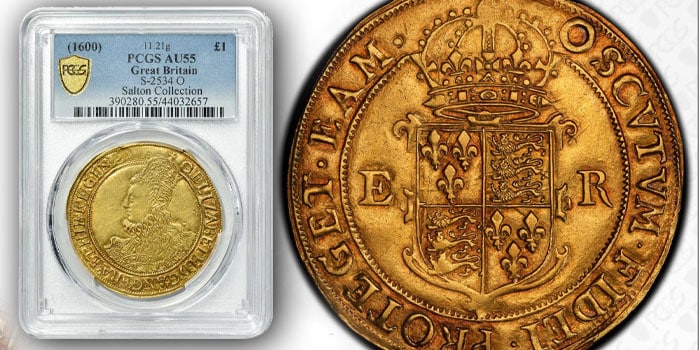
Continuing their successful year of world and ancient coin auctions, Stack’s Bowers Galleries is pleased to present the world and ancient coin auction that is a part of the firm’s slate of sales during the Summer Global Showcase Auction. This impressive array of material from cultures ancient to modern, and from locales spanning the entire globe, will comprise seven live and online sessions, running from August 22 through 30. The number of lots surpasses 3,100, with a total collective higher-end estimate that exceeds $12 million.
One focus of this sale is the number of well-cultivated and well-curated collections that touch upon numerous collecting avenues within world coins.
For aficionados of British coinage, the next installment (Part III) of the Mark and Lottie Salton Collection includes rarities both hammered and milled, with a particular focus upon the large silver issues of Charles I during the English Civil War and gold denominations of the 17th to 19th centuries. Seldom encountered gold Pounds from the very end of the Elizabethan era offer wonderfully detailed portraits of the famous queen. A run of “declaration” types under Charles I channels the strife taking place within the realm at that time—with the 1644 Oxford Pound taking center stage. Within the milled coinage, the 5 Guineas denomination in particular features a number of these majestic specimens. A “fine work” example from the reign of William III displays tremendous quality and a planchet crack that only augments its character.
Continuing the wide array of British coins are those from the highly impressive Augustana Collection. Here gold is the central theme, both hammered and milled, with four milled issues in particular capturing the headlines. These pieces include 5 Guineas of William and Mary and George I, a 5 Pounds issue from George IV, and the fabled “Una and the Lion” 5 Pounds Pattern of Victoria.
Not limited to just British, however, the Augustana Collection also features a tremendous selection of very rare gold denominations from the former country of Czechoslovakia. Likely of greatest consequence among these is the run of 10 Ducats, with the 1930, 1938, and 1951 issues taking center stage. Meanwhile, smaller denominations also present tremendous opportunities for specialists and include the 1938 5 Ducats and Ducat, each with a mintage of just 56 pieces.
Among other European offerings, the Robert C. Knepper Collection features the fruits of a collecting pursuit spanning over four decades, with careful consideration paid to one of the more intriguing aspects of German coinage—the “Wildman”. This seminude, fully bearded figure dominated the early modern coinage of Brunswick-Luneburg and other locales, owing to folklore that often led to his hermetic and barely clothed figure prominently placed within numerous civic coats-of-arms. The Knepper Collection yields tremendous opportunities, with particular stand-outs being a nearly-Choice issue from the reign of Heinrich Julius, another from the reign of Friedrich Ulrich, a “houseboy” Taler issued under August “the Younger”, and a wonderous multiple Taler struck during the reign of Christian Ludwig. There is also an enchanting run of “mining” Talers, coins that celebrated specific mines and their respective outputs, at a time when the area was rich in mineral resources.
Moving eastward into the Russian Empire, the Sigma Collection presents incredible rarities from the 18th century and earlier, with numerous crown-sized varieties from Russia’s first czar, Peter I (the Great), and his immediate Muscovite successors. A near-Mint Ruble dated in old Cyrillic will certainly excite viewers, while a lustrous Ruble from 1720 (NGC MS-66) features a level of quality that is rarely encountered. Also offering Gem-level appeal is a blazing 1743 Ruble from Elizabeth.
Moving westward, Spain and the New World are also extremely well represented, first with the Avrabanel Collection, which offers splendid issues from the Bourbon kings forward, and is particularly expansive in Spain’s 19th-century coinage. With numerous “top pops” and plate coins, this collection should certainly grab attention with a 1728 8 Reales Gem from Segovia, another Gem 8 Reales from the final year in the reign of Charles IV, and a 20 Reales de Vellon of Ferdinand VII — the single finest graded of the issue.
Paralleling these issues is another installment of the impressive Pat Johnson Collection featuring important specimens from colonial possessions in Latin America—a number of which are minor-sized denominations that are not often readily encountered. Among these exciting offerings is a white metal ½ Peso Pattern from Costa Rica, a lovely “Cocobola” 50 Centavos from Colombia, a Danish West Indies countermarked issue with Seated Liberty as host, and a Venezuelan specimen 50 Centavos.




